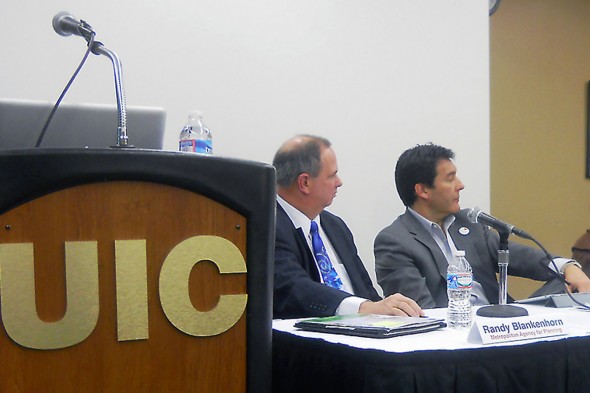Lack of public transit stalls Chicago-area growth

Randy Blankenhorn, executive director of the Chicago Metropolitan Agency for Planning, and Peter Skosey, executive vice president of the Metropolitan Planning Council, discuss public transportation in the Chicago region.
The Chicago region needs more transit riders and fewer drivers if Chicago is to be a world-class city, said a panel of urban planning experts assembled by the Great Cities Institute Dec. 3 to debate the future role of the Regional Transportation Authority.
Expanding ridership is a tall order when transit budgets haven’t covered timely maintenance of the aging infrastructure, let alone extend service to reach jobs in the suburbs as well as in the Loop, the speakers agreed.
The challenge is even greater when four agencies control transit.
The Regional Transportation Authority oversees three transit operators — the CTA, Metra and Pace — with three separate governing boards, said Steve Schlickman, executive director of UIC’s Urban Transportation Center.
“There is a serious lack of accountability when you have such a complex structure,” he said.
“We have complexities not only in governance, but also in service overlap, in capital planning and programming, in the allocation of our finances. These topics defy public understanding.”
Schlickman, who headed the RTA from 2005 to 2010, noted that most regional transit systems in the U.S. are organized as one agency.
Other transit systems have been better funded, panelists said.
Peter Skosey, executive vice president of the Metropolitan Planning Council, said that New York, Los Angeles and Seattle have multiplied their investments in transit over the past 20 years while Chicago has cut funding by 25 percent.
“If we were to develop the transit system today, we’d make it more coordinated. But we don’t have the ability to make a fresh start,” Skosey said.
He stressed that the agencies must develop unified operations, unified marketing and “stellar” transit-oriented development to match regional growth with existing transit.
Skosey pointed to bus rapid transit, as planned for several miles of Ashland Avenue, as one means to make transit more efficient with relatively little capital spending.
Capital spending should make transit a comfortable, convenient first choice, not a last resort, said Randy Blankenhorn, executive director of the Chicago Metropolitan Agency for Planning.
Blankenhorn warned that the region is expected to gain 2 million residents over the next 25 years.
“Simply from the standpoint of logistics, you can’t add that many cars to the highway. And this is no longer a car society. Young people want options,” Blankenhorn said.
“I often say that the company that makes our railcars is making cars for China and India, but they look a lot different. They look like something people want to ride in.”
The last mile of city-to-suburbs commutes is often underserved, said Frank Beal, executive director of Metropolitan Strategies, a business and civic organization.
Beal mentioned the growth of smartphone apps such as Uber and Lyft as alternatives to taxis.
“They’re there because the automobile isn’t doing the job for everybody, and public transit as currently organized isn’t doing the job for everybody,” he said.
Jackie Grimshaw, vice president of the nonprofit Center for Neighborhood Technology, said RTA board members should be appointed through a process that fosters a regional perspective.
“If I’m appointed by the McHenry County chairman, I’m looking at, how can I protect some chance of investment in McHenry County? I am not thinking of what’s best for the region,” she said.
Grimshaw expressed hope that a new appointment process will be recommended by the Northeastern Illinois Public Transit Task Force set up by Gov. Pat Quinn in August, following a scandal over alleged patronage at Metra and an $871,000 severance package to its former CEO. The task force report is to be submitted to the General Assembly in January.
